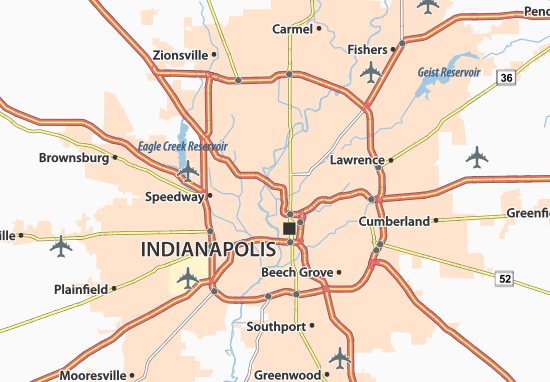Greater Indianapolis
History
The history of Indianapolis spans three centuries. Founded in 1820, the area where the city now stands was originally home to the Lenape (Delaware Nation). In 1821 a small settlement on the west fork of the White River at the mouth of Fall Creek became the county seat of Marion County in 1821, and the state capitol of Indiana, effective January 1, 1825. Initially the availability of federal lands for purchase in central Indiana made it attractive to new settlement; the first European Americans to permanently settle in the area arrived around 1819 or early 1820. In its early years most of the new arrivals to Indianapolis were Europeans and Americans with European ancestry, but later the city attracted other ethnic groups. The city's growth was encouraged by its geographic location, 2 miles (3.2 km) northwest of the state's geographic center. In addition to its designation as a seat of government, Indianapolis's flat, fertile soil, and central location within Indiana and Midwest, helped it become an early agricultural center. Its proximity to the White River, which provided power for the town's early mills in the 1820s and 1830s, and the arrival of the railroads, beginning in 1847, established Indianapolis as a manufacturing hub and a transportation center for freight and passenger service. An expanding network of roads, beginning with the early National Road and the Michigan Road, among other routes, connected Indianapolis to other major cities.
Alexander Ralston and Elias Pym Fordham surveyed and designed the original grid pattern for the new town of Indianapolis, which was platted in 1821. Ralston's plan extended outward from Governor's Circle, now called Monument Circle, a large circular commons at the center of town. The early grid is still evident at the center of downtown Indianapolis, although the city has expanded well beyond its original boundaries. When White River proved too shallow for steamboats and the Indiana Central Canal was never fully completed, railroads helped transform the city into a business, industrial, and manufacturing center. The city remains the seat of state government and a regional center for banking and insurance, which were established early in the town's history. As early as the 1820s and 1830s, the city's residents established numerous religious, cultural, and charitable organizations to address social concerns and to preserve the state's history and culture.
Type
City
Population
2,400,000
Included Locations
- Broad Ripple
- Broad Ripple Club District
- Carmel, IN
- Central Indiana Hospital for the Insane
- City Hall
- City Morgue
- Denison Hotel
- Downtown Corporate Sector
- Downtown Hospital District
- Downtown Media District
- Downtown Nightclub District
- Fountain Square
- in Amman Mosque
- Indiana State Museum
- Indianapolis
- Indianapolis Downtown Central Library
- Indianapolis Greyhound Bus Station
- Indianapolis International Airport
- Marion County Circuit Courts
- Mass Ave.
- Scottish Rite Cathedral
- The Latin Quarter
- Vertellus Specialties Inc.
Remove these ads. Join the Worldbuilders Guild









Comments